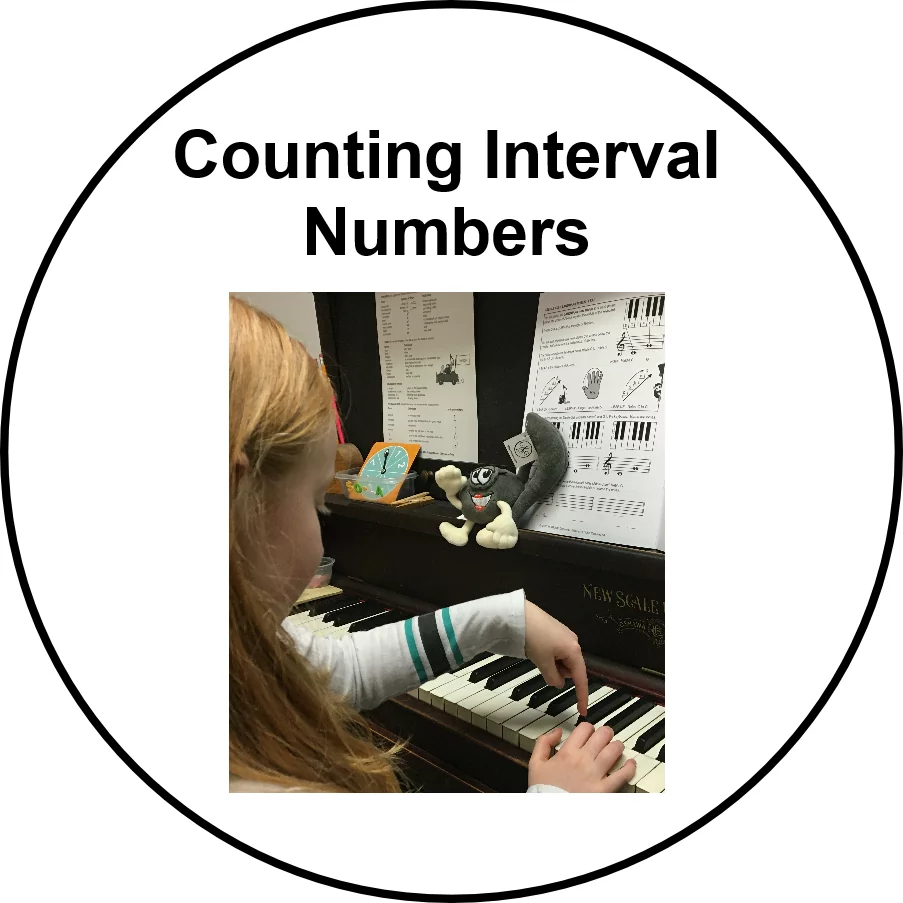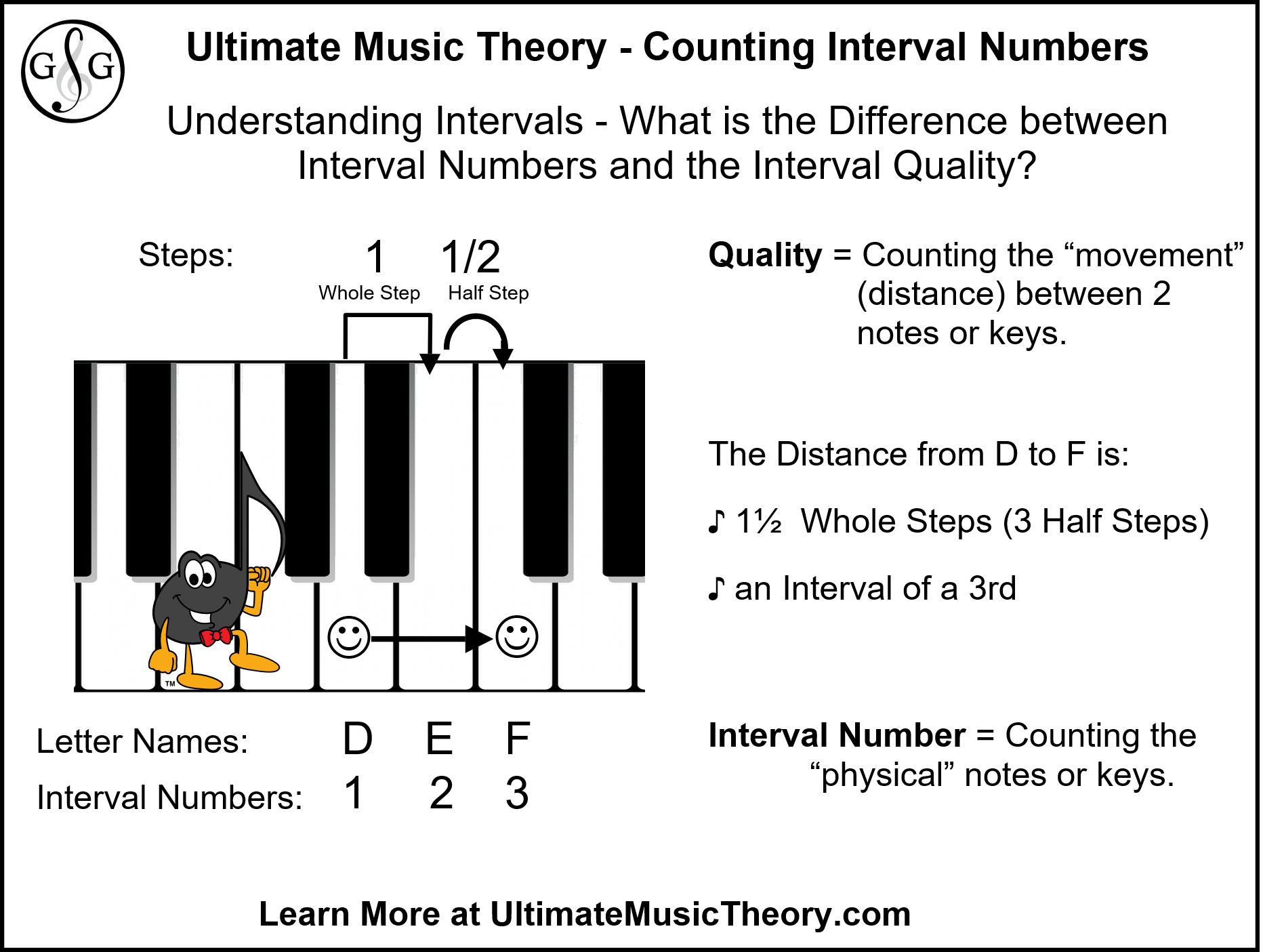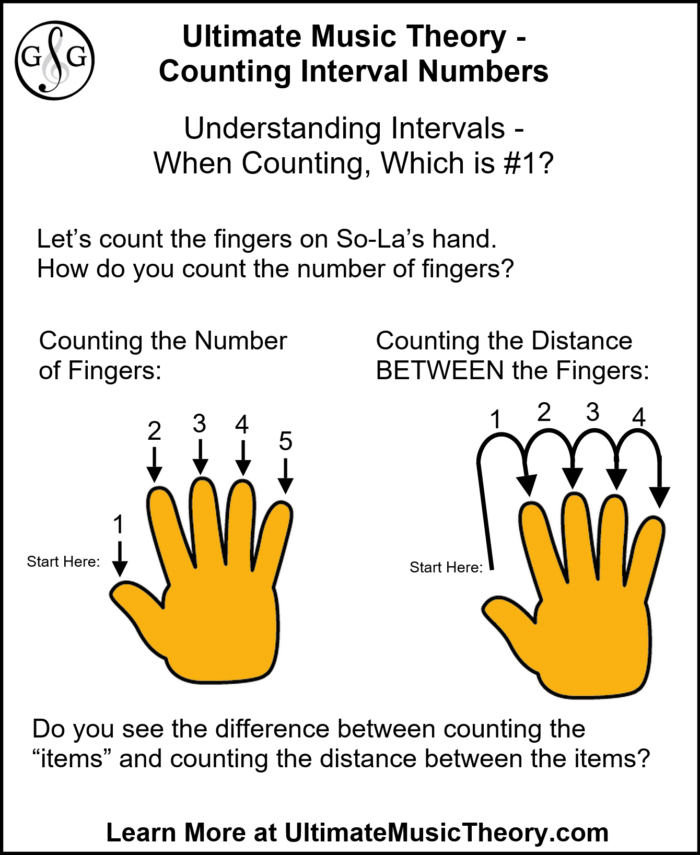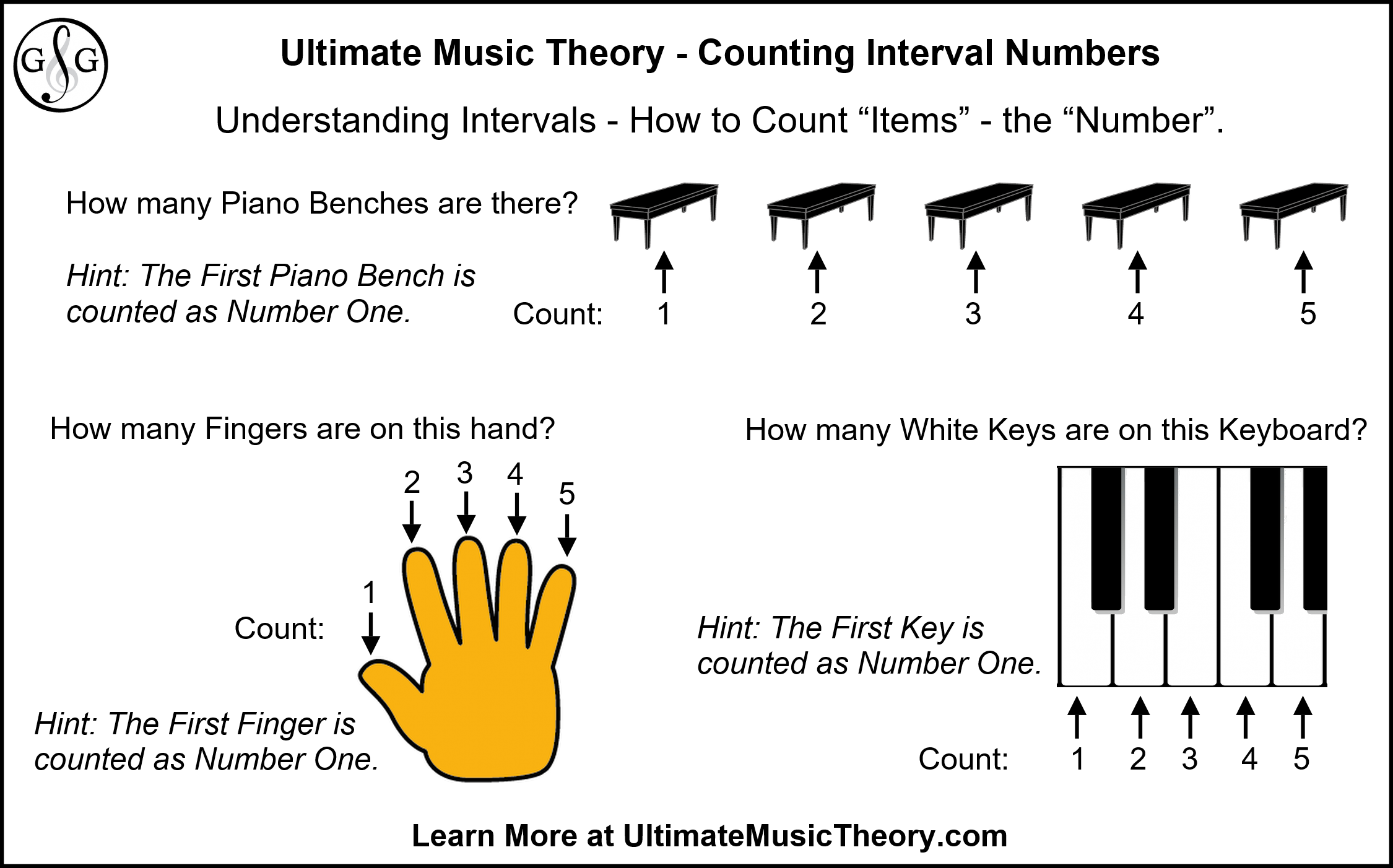Counting Interval Numbers

Have you ever asked a student to name the interval and they tell you that the Interval Number is a 4th when it is most definitely a 5th? That is often because they are counting the steps between the notes instead of counting Interval Numbers.
Many students get confused between counting Interval Numbers and counting the number of steps between the notes (the distances).
An Interval is measuring distances between one (the FIRST) note/key and a second note/key. To measure a distance, you must have a starting point and an ending point. For example:
- we measure the distance from my house to Glory's house in kilometers (1725 km) or in miles (1071.865 miles);
- we measure the distance from my toes to the top of my head in feet & inches (5 feet 5 inches) or in centimetres (165 cm).
- we measure the distance from one key/note to a second key/note in intervals. (White key D up to the white key F is an interval of a 3rd.)
An Interval NUMBER in music is measuring/counting the distance between ONE note/key and another. And remember, we always count our FIRST note/key as Number ONE! D = 1st key; E = 2nd key; F = 3rd key. Therefore, Interval Number from D up to F is a 3rd (3).
The Interval QUALITY/KIND (Major, minor, Perfect, Augmented and diminished) is counting the number of steps between 2 notes (based upon the notes of the Major Scale of the lowest note). In D Major, F is Sharp (D to F# = Major 3rd). When F is made natural, the interval is one half step (one semitone) smaller, so D to F = minor 3rd.
Counting Interval Numbers - What is the Difference between Numbers and Quality?
To identify the Quality/Type of an Interval, the Student must be able to identify the:
- Number: Counting Interval Numbers (1st, 2nd, 3rd, 4th, etc.).
- Quality/Type: Identifying the Interval as Major, minor, Perfect, Augmented or diminished (the "Quality" or the "Type" of the Interval).
For Example: An Interval of a 3rd (the Interval Number) is ALWAYS the distance from ONE letter name to the the THIRD letter name (counting the first letter name as Number One).
The Quality/Type of Interval for a 3rd is either Major, minor, Augmented or diminished.
To identify the QUALITY of the 3rd, one method is to count the number steps between the lower note/key and the upper note/key.
- A Major 3rd is also ALWAYS a distance of 2 whole steps (whole tones) or 4 half steps (semitones).
- A minor 3rd is always 1 1/2 whole steps or 3 half steps.
- A diminished 3rd is always 1 whole step or 2 half steps.
- An Augmented 3rd is always 2 1/2 whole steps (5 half steps).

Believe me, the EASIER way to identify the QUALITY/TYPE of the interval is the way we teach it in the Ultimate Music Theory Series.
In the Prep 1 Rudiments and the Prep 2 Rudiments Workbooks, Students learn to identify the Interval Number by counting interval numbers.
In the Basic Rudiments Workbook, Students learn how to easily identify the Interval Quality/Type by using the Major Scale of the lowest note.
To identify the Interval Quality/Type, Students should not have to memorize the number of steps between the lower and the higher notes in every single Interval from a Perfect 1st to a Perfect 8th. (Remember, there is no diminished 1st. If you are not sure why, read the Blog No Diminished First.)
However, reviewing HOW the number of steps between 2 notes creates the quality/type of Interval, and (for example) how the distance of a minor 3 is always 1 1/2 whole steps (3 semitones), IS fun! Have your Student play the interval of a minor 3 beginning on different keys on the piano to hear how all minor 3rd intervals have the same quality/type of sound.
Counting Interval Numbers - Know HOW to Count!
Repeat after me: The First Key is Number One.
When counting interval numbers, the first key/note is counted as Number One!
Have your students hold up their hand. Now count those fingers.
Do we point to the first finger and then point to the second finger and say "1"? Oops - that is counting the distances BETWEEN the fingers.
We always point to the FIRST "item" and say Number 1! (The First Finger is Number 1!).
And THIS is where Students get confused! Students will count the distance BETWEEN the items instead of counting the ITEMS (the Number).
Here is another "Shelagh Story" on how I teach my students (especially my Special Learning Needs Students) how to count the interval.
(PS - because I live in a French/English community, my students call me Madame Shelagh.)
Mme. Shelagh: What is the interval from A up to E?
Student: 4 because A up to B is 1, B up to C is 2, C up to D is 3 and D up to E is 4.
Mme. Shelagh: Let's count my Fingers!
Student: 1-2-3-4-5! 5 Fingers because the first finger is #1!
Mme. Shelagh: So, what is the interval from A up to E? Where do we start?
Student: The first note is #1. A is 1; B is 2; C is 3; D is 4; E is 5. So A up to E is a 5th!
The next time your student forgets to start on "1" on their given note, remind them that the FIRST note is NUMBER ONE!

Counting Interval Numbers - The Best Beginner Workbook Series EVER!
If you teach young Students, I recommend that you add the Ultimate Music Theory Beginner A, B, C Workbook Series. These Workbooks teach Students how to count Intervals (counting Interval Numbers) and how to count the distances between notes (identifying steps and skips). This theory foundation is outstanding, and it is fun!
These Workbooks can be assigned with Lesson #1 (the first lesson... LOL) and they work with whatever Teaching Method Series you are using. There are also Ear Training, Composing and Sight Reading Activities in the workbooks that will help you inspire your Students.

I do hope that this blog helps you understand why some Students struggle with counting Interval Numbers. Using a Kinesthetic (tactile) approach by counting actually items (and how we move BETWEEN the items) will support learning and understanding this concept.
Now, for a REALLY AMAZING WAY to identify the Quality/Type of Interval (Major, minor, Perfect, Augmented or diminished), take the Ultimate Music Theory Certification Course to become an Ultimate Music Theory Certified Teacher. In the Videos, Glory St. Germain will teach you the Karate Chop Method for Interval Identification.
This Teaching Tool has been invaluable in my own teaching. Want to know a secret? I always struggled with identifying Intervals. When I learned the Karate Chop Method from Glory, it all made sense!
If you have a concept that you struggle with, do not hesitate to send me an email: Shelagh@UltimateMusicTheory.com.
Ultimate Music Teachers Membership
♪ LEARN ♪ PLAN ♪ TEACH ♪ GROW
The One & ONLY Ultimate Music Teachers Membership
To Become A UMT PRO!
Your Success Path Starts Here - Go To TeachUMT.com Today!
Keep on Learning... With a Smile and a Song!
Shelagh McKibbon-U'Ren


